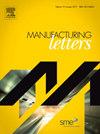An experimental study of ultrasonic-knife cutting for a woven carbon fiber preform by an industrial robot
IF 1.9
Q3 ENGINEERING, MANUFACTURING
引用次数: 0
Abstract
This study investigates the effect of the cutting process parameters on the cutting forces and the quality parameters of a woven carbon fiber preform during robotic ultrasonic-knife cutting. An ultrasonic cutting device, with a power of 1200 W, a frequency of 24 kHz, and an amplitude of 60 µm, mounted on the end effector of a six-axis degree of freedom industrial robot to make linear cuts. A three-level factorial experimental design was used to examine the effect of the feed rate (1 m/min to 5 m/min) and the knife’s attack angle (45° to 75°) on the cutting forces, the dimensional accuracy of the machined preform coupons, and the damage on the machined preform edges. The cutting force analysis results show that the increasing feed rate resulted in increasing feed force and thrust force. However, the increase of the attack angle increases the feed force but decreases the thrust force. The average width and damage of the ultrasonic knife cut preform coupons are highly related to the process conditions. The combination of the low feed rate, 1 m/min, and the low attack angle, 45°, resulted in dimensional errors ranging from 253 μm to 365 μm oversized from the programmed 15.0 mm width with no damage. When the feed became 3 m/min and 5 m/min at the attack angle of 75°, the preform coupons’ dimensional accuracy and damage formation worsened. In these conditions, the ultrasonic knife attached to the industrial robot arm could not cut the preform plate effectively, so the tows on the preform were unevenly cut or dislodged.
利用工业机器人对碳纤维编织预成型件进行超声波刀切割的实验研究
本研究探讨了机器人超声刀切割过程中,切割工艺参数对碳纤维编织预成型件切割力和质量参数的影响。功率为 1200 W、频率为 24 kHz、振幅为 60 µm 的超声波切割装置安装在六轴自由度工业机器人的末端效应器上,以进行线性切割。采用三级因子实验设计,考察了进给速度(1 m/min 至 5 m/min)和刀具攻击角(45° 至 75°)对切割力、加工瓶坯试样的尺寸精度以及加工瓶坯边缘损伤的影响。切削力分析结果表明,进给速度增加会导致进给力和推力增加。然而,增大攻角会增加进给力,但会减小推力。超声刀切割预成型试样的平均宽度和损坏程度与工艺条件有很大关系。低进给量(1 m/min)和低攻击角(45°)的组合导致尺寸误差范围从 253 μm 到 365 μm 不等,超出了 15.0 mm 的编程宽度,且无损坏。当进给量变为 3 米/分钟和 5 米/分钟(攻击角为 75°)时,预成型坯的尺寸精度和损坏情况都有所恶化。在这种情况下,工业机器人手臂上的超声波刀无法有效切割预成型板,因此预成型板上的丝束被切割得不均匀或脱落。
本文章由计算机程序翻译,如有差异,请以英文原文为准。
求助全文
约1分钟内获得全文
求助全文
来源期刊

Manufacturing Letters
Engineering-Industrial and Manufacturing Engineering
CiteScore
4.20
自引率
5.10%
发文量
192
审稿时长
60 days
 求助内容:
求助内容: 应助结果提醒方式:
应助结果提醒方式:


